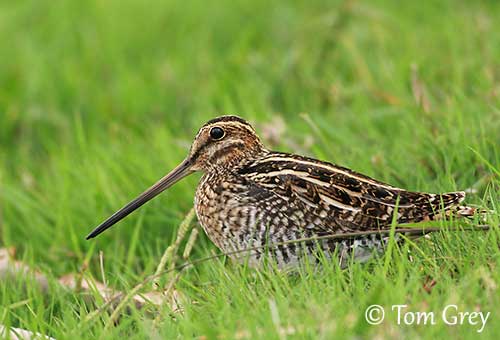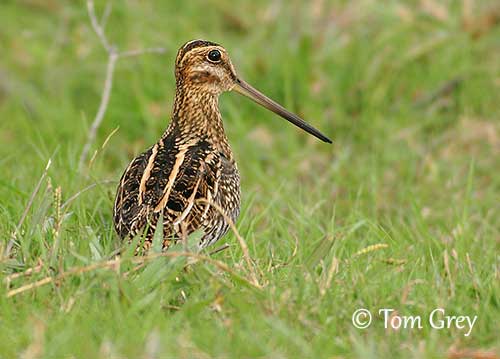
Fr: Bécassine de Wilson
Ang: Wilson’s Snipe
All: Wilsonbekassine
Esp: Agachadiza de Wilson
Ita: Beccaccino nordamericano
Nd: Amerikaanse Watersnip
Sd: wilsonbeckasin
Photographers:
Roger Ahlman
Pbase Galleries Peru and Ecuador
Tom Grey
Tom Grey's Bird Pictures & Tom Grey's Bird Pictures 2
Ken Havard
My Bird Gallery & Flickr gallery 1 & Flickr gallery 2
Otto Plantema
Trips around the world
Text by Nicole Bouglouan
Sources:
HANDBOOK OF THE BIRDS OF THE WORLD Vol 3 by Josep del Hoyo-Andrew Elliott-Jordi Sargatal - Lynx Edicions - ISBN: 8487334202
GUIDE DES LIMICOLES de D. Taylor - Delachaux et Niestlé - ISBN : 2603014080
All About Birds (Cornell Lab of Ornithology)
Bird Web (Seattle Audubon Society)
Wikipedia, the free encyclopaedia
What Bird-The ultimate Bird Guide (Mitchell Waite)
Houston Audubon Society (National Audubon Society)
Wilson’s Snipe
Gallinago delicata
Charadriiformes Order – Scolopacidae Family
INTRODUCTION:
Until 2003, the Wilson’s Snipe was a subspecies of the Common Snipe. It is now a full species, and its name pays tribute to the American ornithologist Alexander Wilson.
This species breeds in a wide northern range in North America and winters from NW and C USA, through Central America to N South America. It frequents a variety of wet habitats but it usually avoids the dense vegetation.
Snipes are known for their dramatic courtship flight display, but they also perform distraction displays to protect both eggs and nest-site against predators.
The Wilson’s Snipe is affected by alteration of water levels, drainage of wetlands and hunting. But currently, the species is not globally threatened.

DESCRIPTION OF THE BIRD:
Biometrics:
Length: 26-28 cm
Wingspan: 40-47 cm
Weight: 80-145 gr
The Wilson’s Snipe resembles Common Snipe, but it differs by white flanks (not buff) with darker and dense black barring.
The adult has cryptically coloured brown, black and grey upperparts involving spotted and barred pattern. There are four whitish lines along the back, formed by a succession of pale spots. The tail is mostly rufous.
On the white underparts, neck and breast are heavily spotted and streaked brown.
On the head, the crown is conspicuously striped black and buffy.
The long, straight bill (6 cm long) is brown with black tip. The eyes are dark brown. Legs and feet are dull yellow.
Male and female have similar plumage, but the female has longer bill and shorter outer rectrices than male.
The juvenile has narrower lines on mantle and scapulars, and the wing-coverts are uniformly fringed pale buff with black subterminal line.
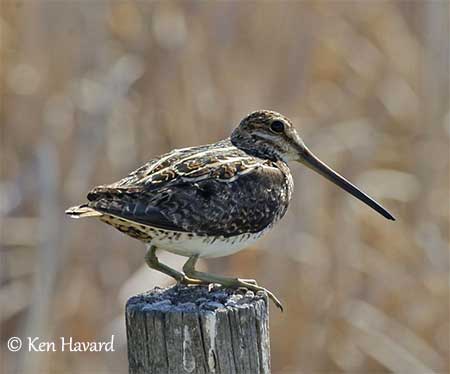
RANGE:
The Wilson’s Snipe breeds in Aleutians and Alaska, E through Canada to Newfoundland, and S to C California, New Mexico, C Iowa and New Jersey. From some recent observations, it also breeds on Chukchi Peninsula in Russia.
This species winters from NW and C USA, through Central America and Greater Antilles to N South America.
HABITAT:
The Wilson’s Snipe frequents a variety of wet habitats such as marshes, bogs and wet meadows. It breeds around freshwater marshes and bogs, shrubby shores along streams and in northern tundra.
During winter and on migration, it can be seen in wet habitats such as fresh and salt water marshes, muddy banks along rivers and around ponds, wet pastures and flooded fields.
In winter, males are usually more common in open habitats whereas females frequent mostly heavily vegetated habitats. In N South America, it is usually found in lowlands, but numerous birds can be seen in Andean páramo, from 3,300 to almost 4,000 metres of elevation.
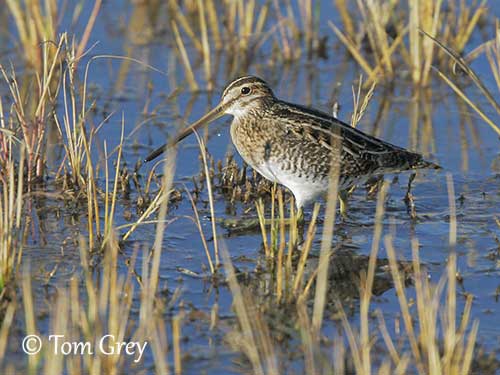
CALLS AND SONGS: SOUNDS BY XENO-CANTO
The Wilson’s Snipe gives a rasping “scaap” when flushed and also while flying during migration. It also produces a hard, sharp “jick” both on the ground and in flight.
During the breeding season, it utters a regular “chip-per, chip-per” and male and female give “tch” sounds during the courtship displays. However, they produce soft clucks to communicate with the chicks.
Like other snipes, the Wilson’s Snipe is known for the “winnowing” display. During this flight, the air rushes over the outspread tail feathers, involving a whirring “hu-hu-hu” sound, usually higher-pitched than in Common Snipe.
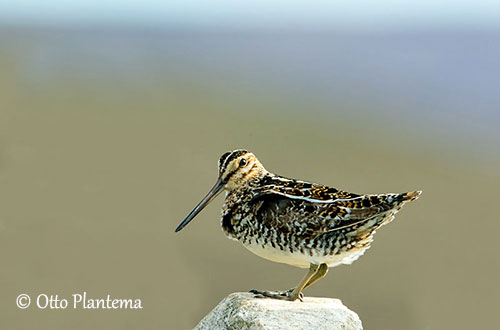
BEHAVIOUR IN THE WILD:
The Wilson’s Snipe feeds primarily on insects and earthworms. It prefers insects found in damp soil or in shallow water such as larvae of crane flies, horse flies, some beetles and numerous other species. Depending on the place, it also takes many earthworms. But its diet also includes leeches, crustaceans, molluscs, spiders, frogs, seeds and leaves.
It probes in soft mud with its long bill, and uses the sensory receptors placed at bill tip to locate the prey. Other food items are taken in shallow water or from ground surface.
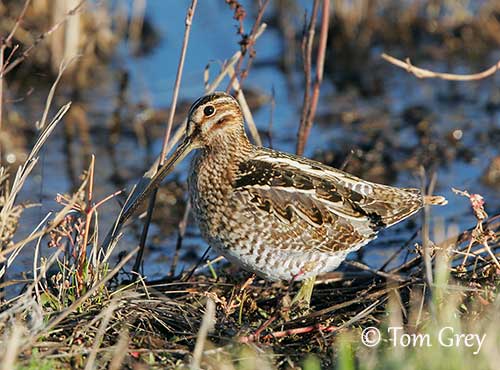
The Wilson’s Snipe performs spectacular aerial displays at the beginning of the breeding season. The male (and sometimes the female) circles and dives over the territory with spread tail feathers. During the dive, the vibration of the outer rectrices produces a hollow whinnying sound.
This type of flight is used in courtship, but also to rebuff predators. The male performs this flight when advertising and defending the territory.
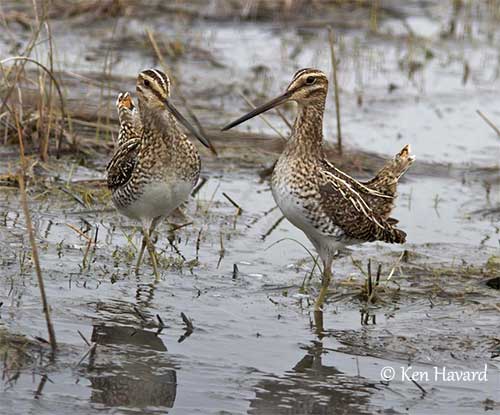
The Wilson’s Snipe is mostly migratory, but some populations are sedentary or partially migratory in North America. The others travel long distances to reach Central America and N South America.
The species is vagrant to W Europe, Azores, Bermuda, Canary Islands, Hawaii, Midway, Wake Island and Saipan.
It has zigzag flight on take-off, and then followed by direct flight with rapid wingbeats.
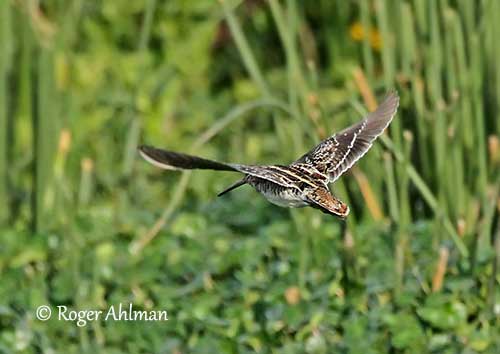
Bird observed in Ecuador
where this species is rare
REPRODUCTION OF THIS SPECIES:
The laying takes place from early May to late July. The Wilson’s Snipe is monogamous and territorial.
The nest-site is selected by the female that makes several scrapes accompanied by her mate. The nest is on the ground, usually hidden by vegetation and placed atop or on the edge of a hummock, with sometimes overhanging plants woven to form a canopy. The depression is lined with softer grasses, leaves or moss. Some vegetation is regularly added through the laying period.
The female lays 3-4 brown to olive-buff eggs with darker markings. She incubates alone during 18-21 days. The chicks leave the nest very soon after hatching, and parents often split the brood. Each adult cares for 1-2 chicks and feed them until they are able to find their own food. They fledge about 19-20 days after hatching.
Both parents perform distraction displays, often feigning an injury, to drive the predators away from chicks or nest-site.
PROTECTION / THREATS / STATUS:
The Wilson’s Snipe is still widespread and common, but it depends heavily on wetlands, and drainage or conversion of these habitats affects the species. Variations in water levels reduce food availability, and hunting occurs in several regions.
However, the Wilson’s Snipe has adapted to wet pastures, ricefields and wet, fallow fields in migration and on wintering areas.
The population is estimated to number 2,000,000 individuals. It is slightly declining but not globally threatened.
The Wilson’s Snipe is currently evaluated as Least Concern.
